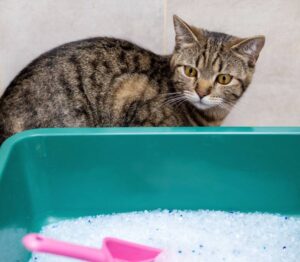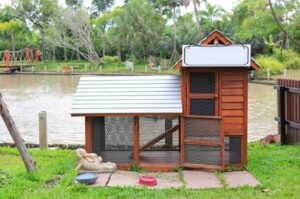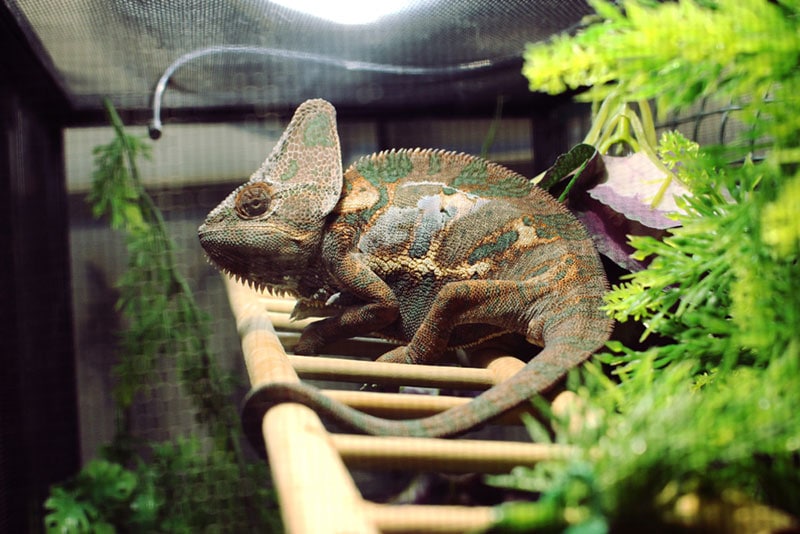
Chameleons primarily live in Africa and reside in forests and deserts. They can make good pets because they are relatively small, although they do need more terrarium space than some other species like geckos. They are also colorful, don’t make much fuss, and are fun to watch.
However, they do have specific cage requirements. They are arboreal reptiles, which means they like to climb and benefit from a tall cage rather than a wide one. You also need to maintain a good temperature gradient and ensure appropriate humidity levels while providing good airflow through the cage.
Getting the right cage is paramount to ensuring a comfortable habitat in which a Chameleon can thrive. It is recommended that the terrarium have a minimum capacity of 100 gallons and measure 2 x 2 feet while being 4 feet tall, although there is room for a little variance in the dimensions.
Below, we look at the best Chameleon cages to help you develop the best setup in your home.

A Quick Comparison of Our Winners (2024)
| Rating | Image | Product | Details | |
|---|---|---|---|---|
| Best Overall | Zoo Med ReptiBreeze LED Deluxe Habitat | Check Price | ||
| Best Value | Zoo Med Reptibreeze Reptile Cage | Check Price | ||
| Premium Choice | Repti Zoo Large Reptile Terrarium | Check Price | ||
| Exo Terra Screen Terrarium | Check Price | |||
| Zoo Med Deluxe Chameleon Kit | Check Price |
The 7 Best Chameleon Cages
1. Zoo Med ReptiBreeze LED Deluxe Open Air Aluminum Screen Habitat – Best Overall
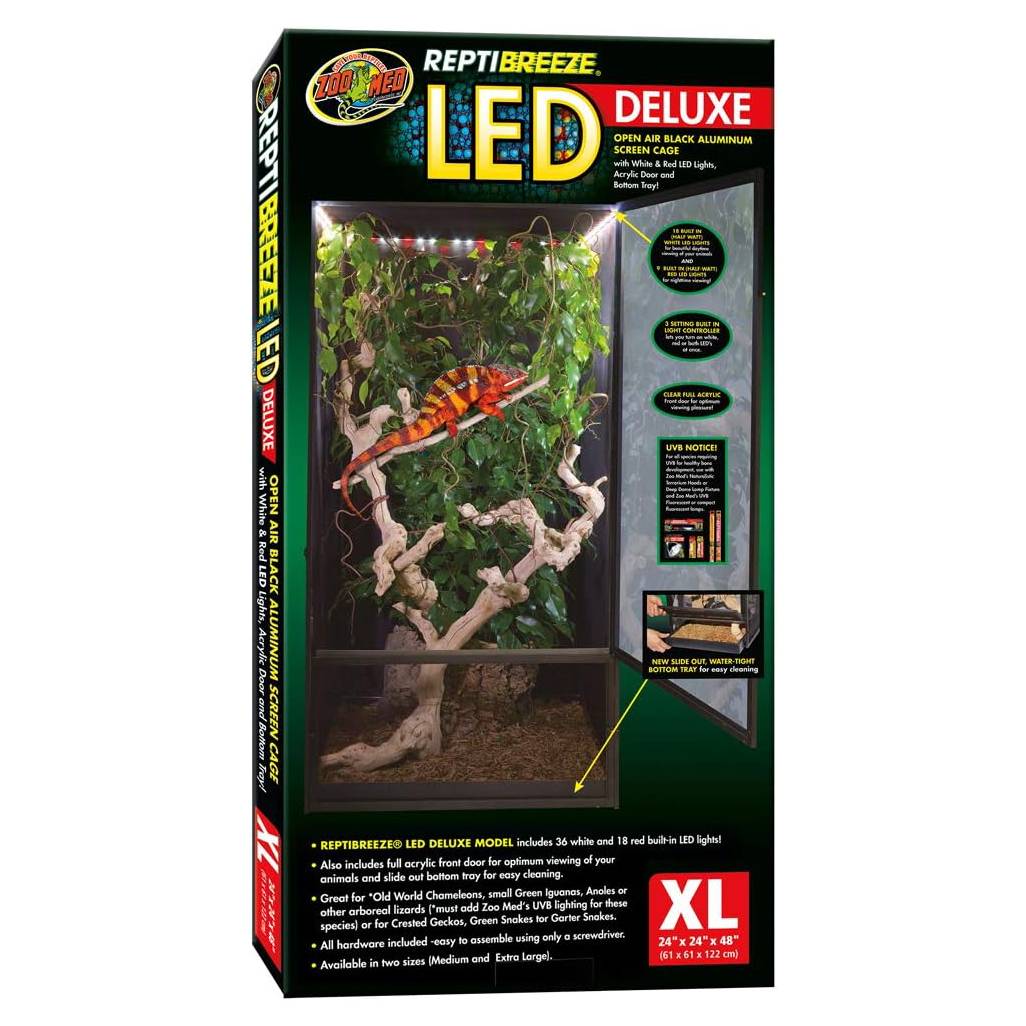
| Terrarium Type: | Screen |
| Capacity: | 120 Gallons |
| Dimensions: | 24 x 24 x 48 Inches |
The Zoo Med ReptiBreeze LED Deluxe Open Air Aluminum Screen Habitat meets the ideal size requirements for a Chameleon cage. It measures 2 x 2 x 4 feet, with the height being beneficial because it allows you to add branches and foliage which, in turn, give your chameleon plenty of room to climb.
It has screen walls that give plenty of ventilation, which is important for Chameleons because it helps prevent respiratory infections and breathing problems. It uses treated aluminum meshes, which are designed to last longer, and the Deluxe Aluminum Screen has a removable bottom tray that makes it easy to clean the terrarium out. It also has a clear, acrylic door and LED lights which combine to give you a great view of your reptilian pet.
And, while it does use premium materials and offers good space, the Zoo Med is very reasonably priced, making it the best overall Chameleon cage. However, the acrylic door is prone to getting scratched and although the lights have three settings they are fairly limited.
- Reasonable price for a good quality terrarium
- Screen walls offer plenty of ventilation
- LED lights and acrylic door offer greater visibility
- Removable bottom tray is easy to clean
- Acrylic door is easily scratched
- Light functions are limited
2. Zoo Med Reptibreeze Reptile Cage, XL – Best Value
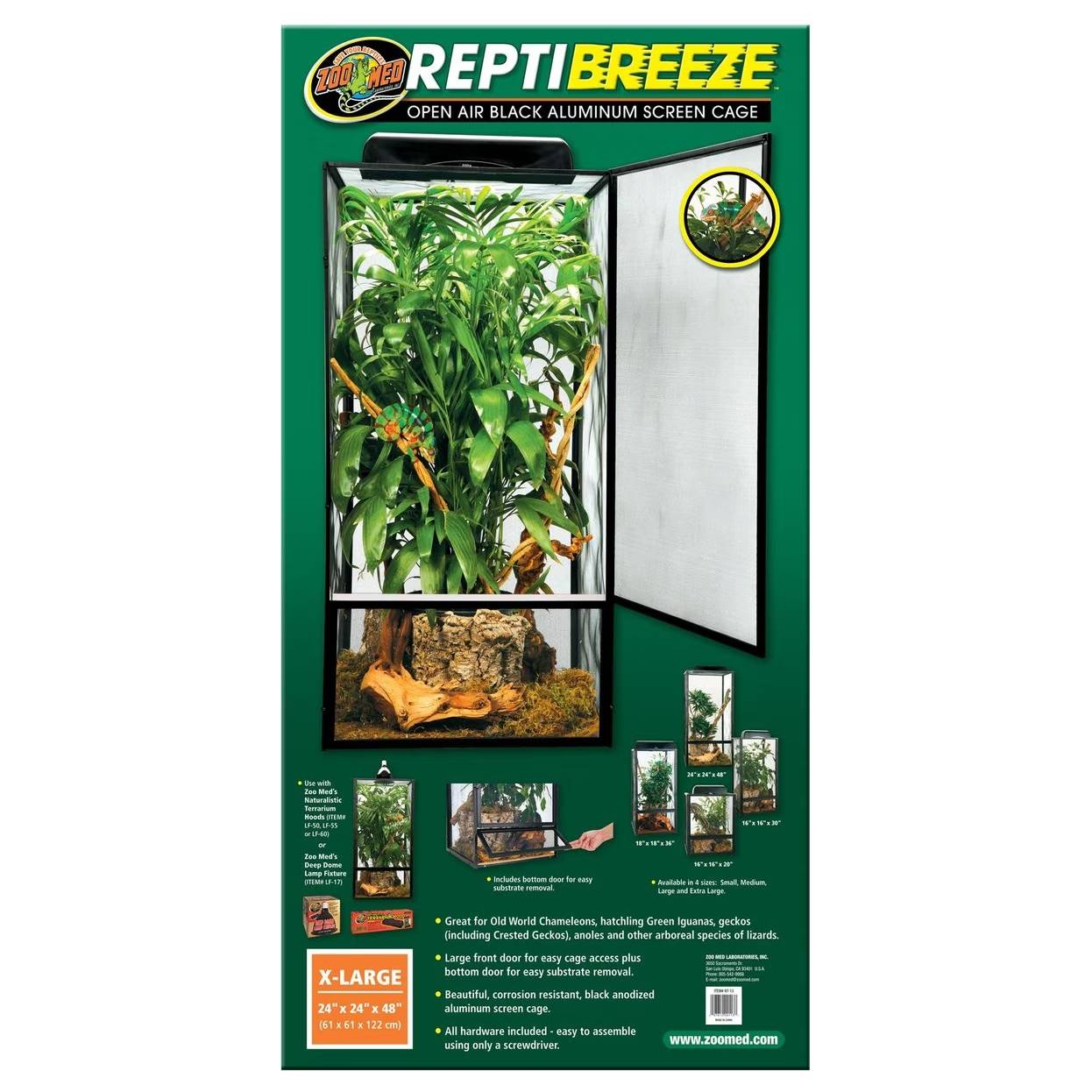
| Terrarium Type: | Screen |
| Capacity: | 120 Gallons |
| Dimensions: | 24 x 24 x 48 Inches |
The Zoo Med Reptibreeze Reptile Cage is essentially the same as the Deluxe model above, but it uses standard aluminum and it has a mesh door, rather than an acrylic one. This does mean that the door is not prone to scratching, like the acrylic door, but your view is a little more restricted and is further impeded by the lack of LED lights that are found in the deluxe model.
However, the price is a lot cheaper, the dimensions are ideal for a Chameleon cage, and the cage does have a bottom door to make cleaning the base easier, as well as a main door for easier handling and to allow you to get branches and foliage into the enclosure.
The low cost and good size of the Zoo Med Reptibreeze Reptile Cage make it the best Chameleon cage for the money, but it is very lightweight so you may want to find a way to stabilize it. And although you can still see your Chameleon through the mesh, it isn’t as visible as it is through the acrylic door of the deluxe version.
- Very low price
- Mesh door doesn’t scratch
- Bottom door gives easy access to cleaning
- Very lightweight
- Lacks the visibility of an acrylic door and LED lights
3. Repti Zoo Large Reptile Terrarium – Premium Choice
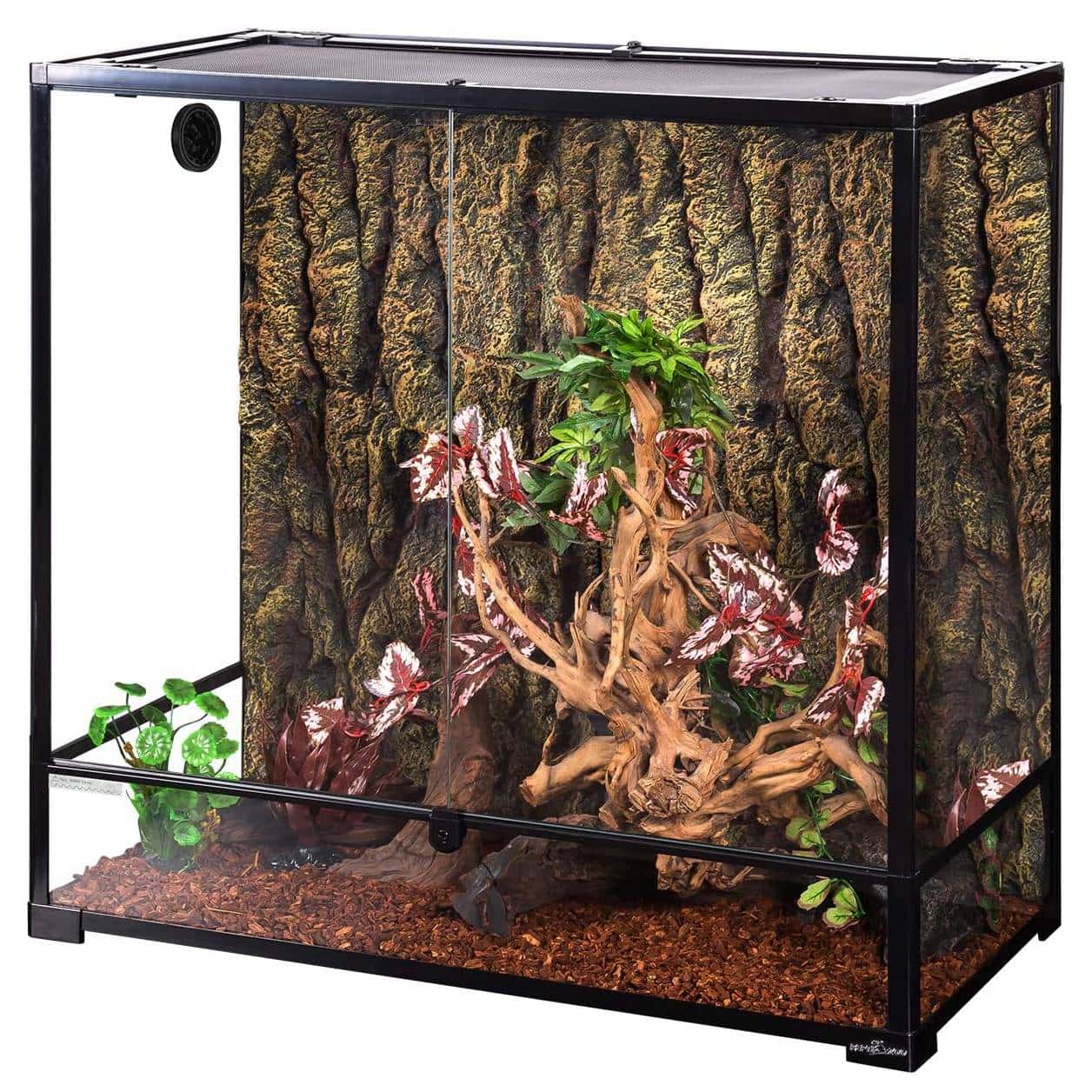
| Terrarium Type: | Glass |
| Capacity: | 100 Gallons |
| Dimensions: | 36 x 18 x 36 Inches |
The Repti Zoo Large Reptile Terrarium is a little shorter but longer than the two cages above. It meets the minimum capacity requirements for an adult Chameleon although it would benefit from being a little taller to provide vertical climbing space. It is a glass terrarium, which means it is more stable and secure, and it does have a mesh lid so that you can get some air into the tank and ensure some ventilation. You may need to look at ways you can circulate more air in the future, though.
The tempered glass base has room for substrate heating and six closable inlets can be used to pass wires through and to ensure that you can offer all the lighting and heating your Chameleon needs. There is a lower door for easy cleaning and a larger upper door for adding and removing décor items and your Chameleon.
The Repti Zoo is expensive and there are a few niggles to contend with, such as the lock being a little flimsy and the lid not being as secure as you might like.
- Tempered glass construction is stable and secure
- Six wire inlets allow for plenty of lights and heaters
- Mesh lid provides some ventilation
- Expensive
- Some minor niggles are disappointing for a pricey terrarium
4. Exo Terra Screen Terrarium, Large
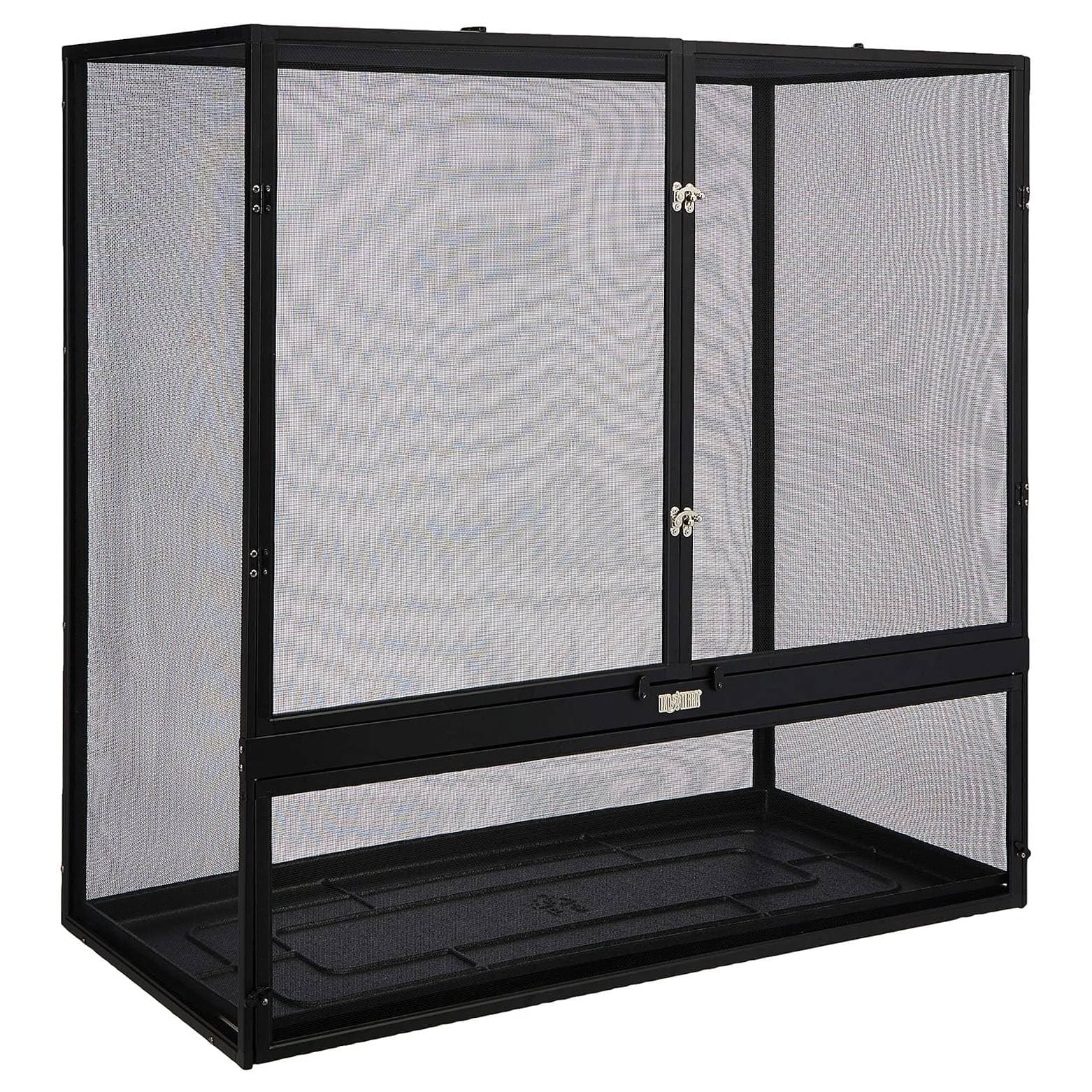
| Terrarium Type: | Screen |
| Capacity: | 100 Gallons |
| Dimensions: | 36 x 18 x 36 Inches |
The Exo Terra Screen Terrarium is an aluminum mesh screen terrarium that measures 36 x 18 x 36 inches, which means it has a capacity of 100 gallons and is a suitable size for a Chameleon. It is made using corrosion-resistant anodized aluminum. And according to Exo Terra, the mesh is cricket-proof, so you shouldn’t have issues with insect escapees. It has large front doors to allow full access to the inside of the cage, as well as a smaller swiveling door at the bottom that can be used for a quick clean of the substrate.
However, the Exo Terra Screen Terrarium is expensive for a fairly basic aluminum mesh terrarium that doesn’t include any extras or stand-out features, and as is the case with most screen terrariums, it is lightweight and can be quite easily knocked over.
- Anodized aluminum is corrosion proof
- The mesh is designed to prevent crickets from getting out
- Large front door and smaller bottom door allow easy access
- Expensive for what it is
- Lightweight and a little flimsy
5. Zoo Med Deluxe Chameleon Kit
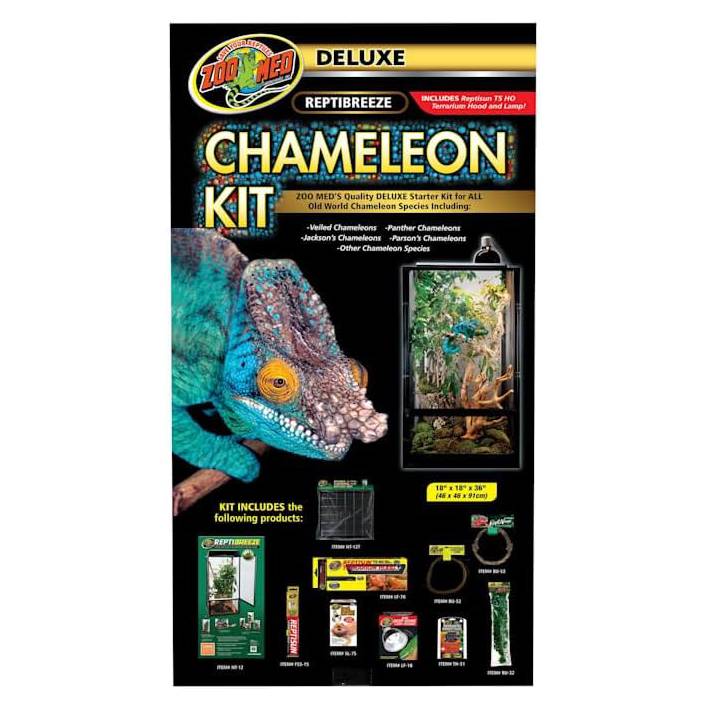
| Terrarium Type: | Screen |
| Capacity: | 50 Gallons |
| Dimensions: | 18 x 18 x 36 Inches |
The Zoo Med Deluxe Chameleon Kit includes an 18 x 18 x 36-inch screen cage as well as a ReptiSun hood, UVB lamp, dome fixture, and a basking lamp. It also comes with a grapevine and a large fake plant. There’s also a thermometer to measure the temperature within the enclosure. The enclosure has a large top door and a smaller bottom door, providing whatever access you need.
It is on the expensive side, but you do get most of the décor and other items you need to ensure that your Chameleon is comfortable, making the price much more reasonable. Unfortunately, there’s no hygrometer to measure humidity and because you will want a heat gradient across the cage, you will benefit from having a second thermometer so you can monitor the temperature at both ends of the terrarium. The size of the terrarium is also too small. It has roughly half the ideal capacity and is a little lacking in height.
The Chameleon kit would be suitable for a young or juvenile Chameleon but once it reaches full size, usually at around 18 months, it will need something bigger that offers more climbing space.
- Includes a heat lamp, UVB light, and fake plants
- Top and bottom doors provide good access
- Mesh walls offer good ventilation
- Expensive for its size
- Too small for an adult Chameleon
6. Exo Terra Rainforest Habitat Kit
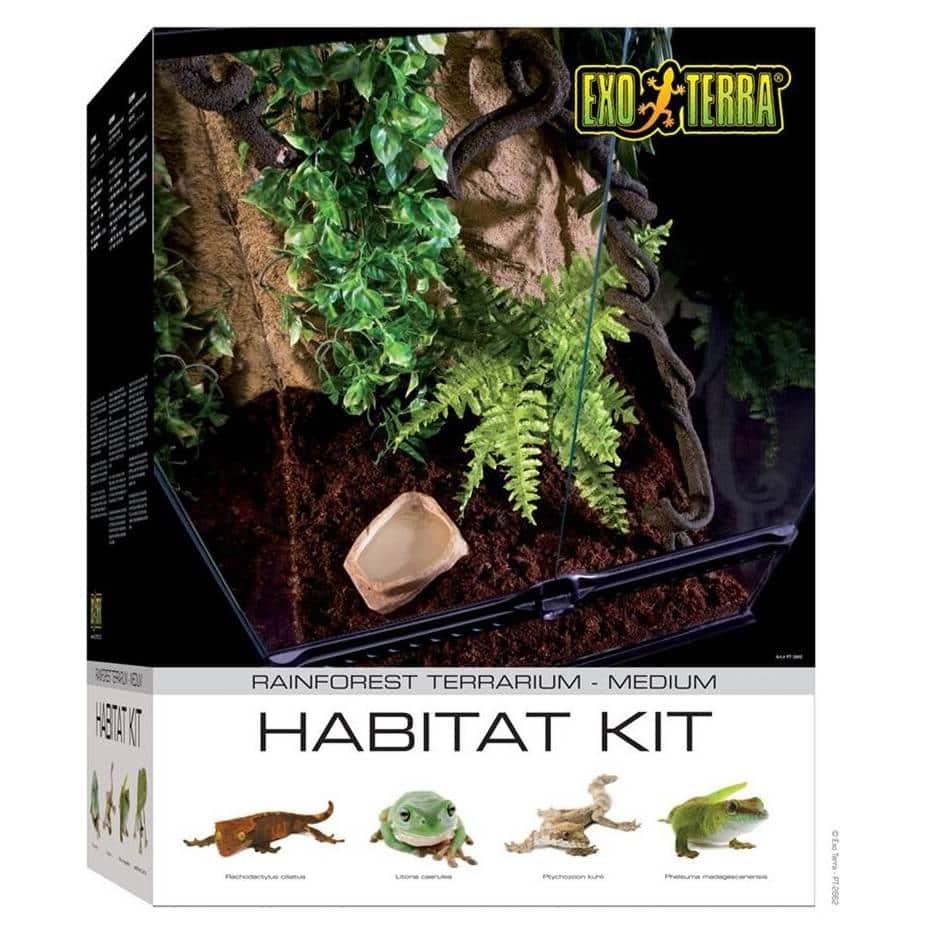
| Terrarium Type: | Glass |
| Capacity: | 35 Gallons |
| Dimensions: | 18 x 18 x 24 Inches |
The Exo Terra Rainforest Habitat Kit is another terrarium that is only suitable for young Chameleons, measuring 18 x 18 x 24 inches. If you’re trying to breed Chameleons and will need a starter terrarium for your hatchlings, it could be a good choice, not least because this is a habitat kit so it includes items to decorate the tank as well as a substrate for the base, vines, rope, and a water dish.
It is quite expensive for a smaller cage and you will still need to buy a heater and light, as well as a thermometer and hygrometer, but it does have ventilation in the front window and the lid so you should be able to get the environmental conditions just right for your Chameleon.
- Includes several accessories
- Ventilation in front window and lid
- You will need to upgrade when your Chameleon is about 18 months
- Expensive
7. OIIBO Large Glass Reptile Terrarium
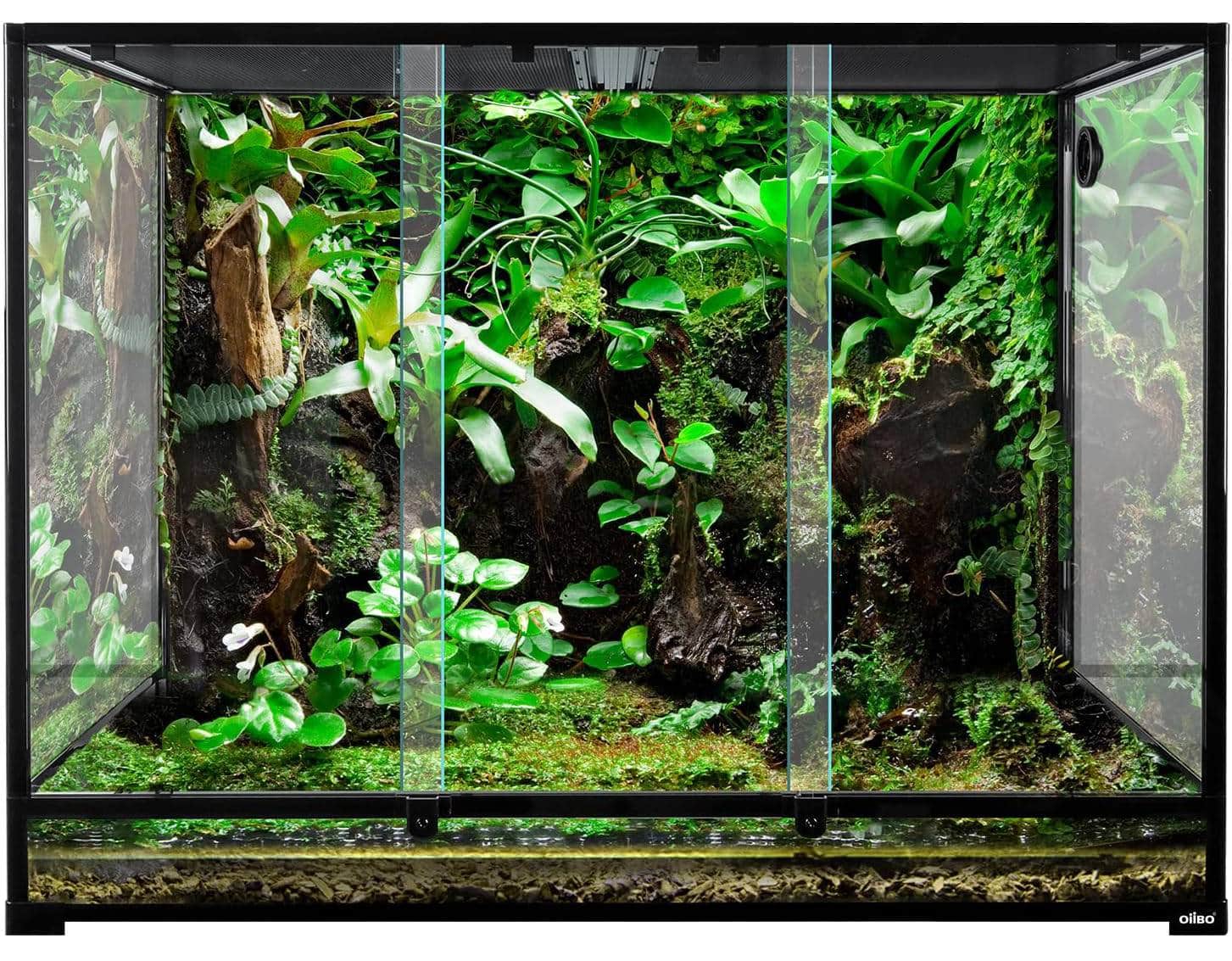
| Terrarium Type: | Glass |
| Capacity: | 180 Gallons |
| Dimensions: | 48 x 24 x 36 Inches |
The OIIBO Large Glass Reptile Terrarium is the largest cage on this list, measuring 4 x 2 x 3 feet and with a 180-gallon capacity. Considering most experts recommend that you do not keep two or more Chameleons together, this is a lot of space for a single Chameleon.
The 180-gallon tank is made using tempered glass and it is strong and safe. It has a top mesh panel, which offers some ventilation, and the front of the tank features double sliding doors. The door also has a double lock to prevent accidental opening and to stop inhabitants from being able to escape. Inlets in the lid of the enclosure allow wires to pass in and out without compromising the stability and security of the cage.
The OIIBO is very expensive and larger than most people will require but it does offer a lot of space and is a strong construction that will safely and securely house your Chameleon.
- Lots of space for your Chameleon
- Tempered glass construction is strong
- Double sliding doors have a secure double lock
- Very expensive
- Too large for most users

Buyer’s Guide: How to Pick the Best Chameleon Cages
Chameleons are heavier and larger than Bearded Dragons but not as big as Iguanas. They are not considered ideal for first-time lizard owners, although there is no reason a first-time owner can’t successfully keep one, as long as they undertake plenty of research and ensure they have all the necessary equipment and items.
One of the most important pieces of equipment for a Chameleon is the cage or enclosure. It needs to be an appropriate size and shape. It also needs to be secure, enable you to incorporate items like lights and heat lamps, and it should provide enrichment like plants, branches, and vines. Below, we look at some of the features you need to look at when buying a Chameleon cage to help ensure that your pet lizard is comfortable, safe, and healthy.

Enclosure Type
Essentially, there are two options when it comes to enclosure types for Chameleons: mesh or glass. However, there are also hybrid cages that combine the two features.
- Mesh cages use a fine mesh, typically made from aluminum, for all of the walls and the lid, with a solid base. They tend to be less expensive and they are beneficial to Chameleons because they allow good ventilation. But, they can be quite lightweight and flimsy. You need to be careful with them to ensure they don’t get knocked over because this can cause injury and stress to your little Chameleon. And, while mesh cages do offer natural ventilation, it can be a lot more difficult to control humidity and temperature because any heat will be allowed to escape.
- Glass cages are heavier and stronger, and are less likely to be knocked over or broken. They also offer unimpeded views into the enclosure. But, as well as being more expensive than mesh cages, they do not naturally offer ventilation. Some glass cages make up for the lack of ventilation in the walls and doors by using a mesh lid or offering some kind of ventilation system in the doors. With a glass cage, it is much easier to control humidity levels and keep temperatures at a desirable and consistent level.
- Hybrid cages combine glass and mesh. They may have one or two glass sides and the rest of the surfaces are made from mesh. Or, the bottom sections of the walls might be glass with the top sections made of mesh. These do make it easier to control humidity, temperature, and ventilation, but they are difficult to find compared to mesh or glass enclosures.
Enclosure Size
As well as deciding on the type of enclosure you want, you need to ensure that it is a suitable size for your Chameleon. Most experts recommend that Chameleons be kept alone, rather than in pairs or groups of Chameleons. Keeping multiple Chameleons in the same enclosure means they will be highly likely to fight over food, basking position, and territory. Fights can lead to injuries and may even result in the death of one of the Chameleons.
It is advised that a Chameleon cage has a minimum capacity of at least 100 gallons, which is quite large for a lizard enclosure. What’s more, Chameleons are arboreal, which means they spend most of their time in trees. While a lot of enclosures are longer than they are tall, a Chameleon enclosure needs to be taller. An ideal size for a Chameleon cage is considered to be 2 feet long, 2 feet wide, and 4 feet high. This exceeds the 100-gallon minimum capacity and meets the lizard’s desire to climb. You can get away with a slightly shorter enclosure but if you can find a tall cage that meets these dimensions, and you have the space, your Chameleon will benefit from it.
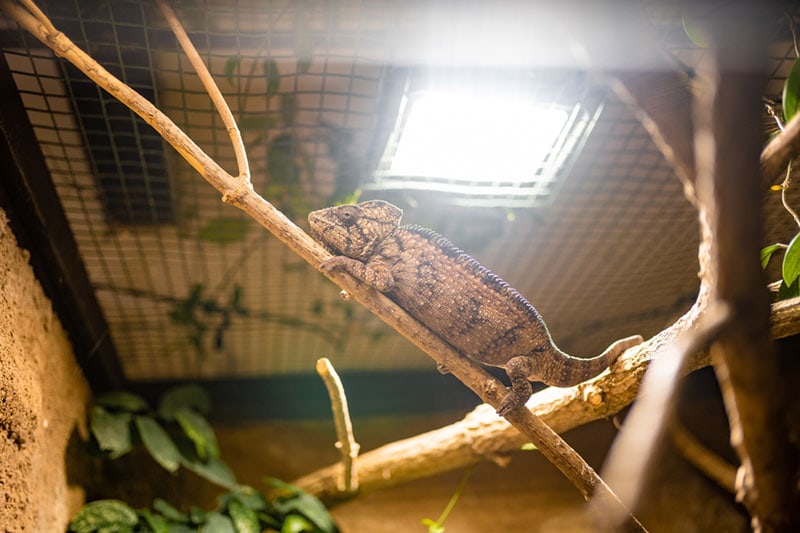
Doors
The enclosure will need doors. A door is not only used as an entrance and exit when getting your Chameleon in and out of the cage. It is also used to put items like large branches and vines in the cage and you will need regular access to the inside of the cage to be able to clean it, refill the water bowl, and put food inside. Most cages have a large door, which allows some access to all of these things, but some of the larger enclosures also have a separate door below this.
The lower door gives you access to the bottom of the cage so that you can clean the substrate or slide bowls and food in without opening up the whole front of the enclosure.
Inlets
Enclosures typically have front opening doors because these are more convenient and they make it easier to put items in and take them out of the cage. This means that the top or the lid of the cage is only really used to prevent your Chameleon from climbing out and to act as rigging for lighting and other features. An enclosure may also feature inlets in the lid or the top corners of the walls. These inlets enable you to pass a wire through them and typically form a seal around the wire. The seal prevents insects, as well as humid, warm air from getting out.
The number of inlets can vary from just a couple to six or more. If an enclosure doesn’t have these inlets, you will have to find other ways to run the necessary wires to lights and heat lamps.
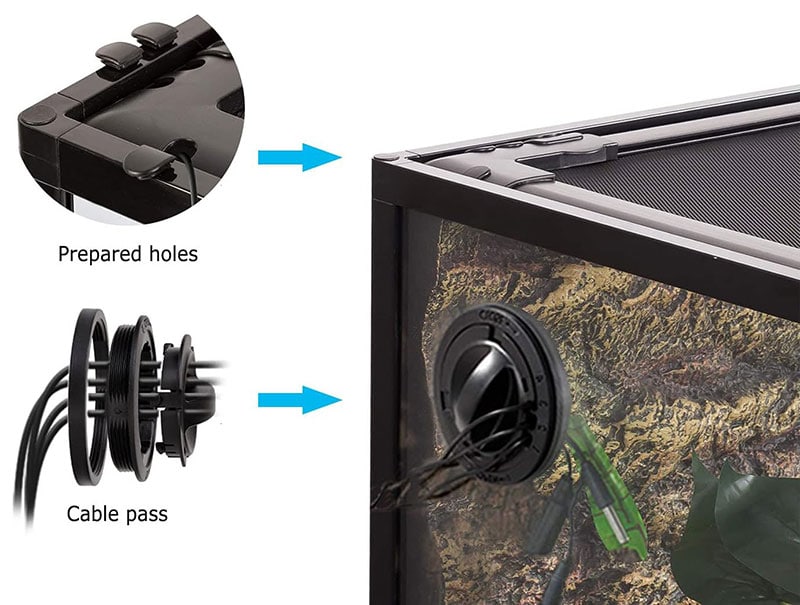
Locks
Chameleons aren’t especially known for escaping their enclosures, although there are undoubtedly exceptions to this and some highly skilled Chameleon escapologists. However, whether an enclosure has sliding or hinged doors, there is a risk of accidental opening, for example by knocking or nudging as you pass the door. Locks or some kind of mechanism to prevent accidental opening can be found on a lot of doors. While a key lock may not be necessary from a security point of view, the turning of the key is likely more secure than a latch or other form of mechanism and can prove very useful.
Ventilation
Ventilation is important in a Chameleon’s enclosure. If the air inside the enclosure is not refreshed often enough, it not only becomes stale but it can cause respiratory problems for your Chameleon. With mesh cages, this shouldn’t be a problem because they essentially offer full ventilation. The air inside the cage is replaced by air from outside the cage constantly. With glass cages, however, you have to find an alternative means of ventilation and this is one of the reasons that many Chameleon owners prefer mesh or hybrid cages over glass.
Some manufacturers put ventilation systems in the windows. These are essentially some form of opening that allows the circulation of air but does not allow Chameleons or even their insect food to get out.

Frequently Asked Questions
What Do You Need to Put In the Cage?
Chameleons need several items inside their enclosure. They need a UVB light, heat light and basking light, and they need a water bowl. They also need some kind of plant, be it real or fake, and some vine or other item they can climb. You should also put substrate on the ground of the enclosure and you may want to add backing to one or more of the walls: this backing helps keep heat in, which is especially important in a mesh cage.
Do Chameleons Like to Be Held?
Chameleons will tolerate being held, but they may not take to it straight away, which means that you will have to spend some time every day getting your little lizard out of the cage. Be aware that Chameleons can become stressed if they are out of their cage for too long so keep handling time down to a few minutes and if you see signs of stress from your Chameleon, put them back in straight away.

What Do Chameleons Eat?
Chameleons are primarily insectivores. They will eat a range of different insects from roaches and crickets to household flies. Some species also eat fruit and vegetables, although some are strict insect-eaters only. Research the exact species of Chameleon you own, or are buying, to make sure you offer an appropriate diet.
Regardless of species, your Chameleon will benefit from being given a good variety of different insects rather than just feeding the same insects every time you feed.
Do Chameleons Shed?
Chameleons, like all lizards, do shed their skin. This is because a lizard’s skin does not grow and has no elasticity, unlike the skin of mammals. So, as the Chameleon grows, it outgrows its existing skin and needs to produce a new layer. If the skin gets damaged, it doesn’t repair in the same way as mammal skin, either, and the whole layer of skin essentially needs to be replaced.
Young Chameleons can shed every few weeks. Adults may only shed two or three times a year.

Conclusion
Chameleons are incredible little lizards that are best known for their ability to change the color or shade of their skin. Not all species have this ability, and despite what many people believe, those that do have the capability to change their color according to factors like mood, health, and temperature, rather than to blend in with the background. If you are considering getting a Chameleon to experience this color changing or because you want a quiet and interesting lizard, the first step is to ensure that you get a suitable, high-quality enclosure that meets your Chameleon’s needs.
Above are reviews of the best Chameleon cages. We found the Zoo Med ReptiBreeze LED Deluxe Open Air Aluminum Screen Habitat to be the best enclosure, being made from anodized aluminum and offering the right amount of space for an adult Chameleon. While that model has LED lights and an acrylic door that facilitates better viewing, the standard version of the same enclosure, the Zoo Med Reptibreeze Reptile Cage, is cheaper and it has the added benefit that there is no acrylic door to scratch.
You Might Also Be Interested In:
Featured Image Credit: the_chris_spencer, Shutterstock
Contents
- A Quick Comparison of Our Winners (2024)
- The 7 Best Chameleon Cages
- 1. Zoo Med ReptiBreeze LED Deluxe Open Air Aluminum Screen Habitat – Best Overall
- 2. Zoo Med Reptibreeze Reptile Cage, XL – Best Value
- 3. Repti Zoo Large Reptile Terrarium – Premium Choice
- 4. Exo Terra Screen Terrarium, Large
- 5. Zoo Med Deluxe Chameleon Kit
- 6. Exo Terra Rainforest Habitat Kit
- 7. OIIBO Large Glass Reptile Terrarium
- Buyer’s Guide: How to Pick the Best Chameleon Cages
- Frequently Asked Questions
- What Do You Need to Put In the Cage?
- Do Chameleons Like to Be Held?
- What Do Chameleons Eat?
- Do Chameleons Shed?
- Conclusion



